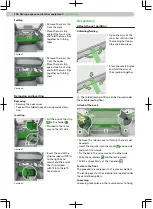
Wheels
Tyres and rims
What you should be mindful of
NOTICE
▶
Protect tyres from contact with lubricants and
fuel.
▶
Always store wheels or tyres in a cool, dry and,
where possible, dark place. Tyres without rims
should be stored in an upright position.
▶
Alloy rims can be damaged by grit.
Causes of uneven tyre wear
▶
Improper tyre pressure.
▶
Driving style (e.g. fast cornering, rapid acceleration
and deceleration).
▶
Wheel alignment errors.
▶
Incorrect wheel balancing.
Wheel changes
For uniform wear on all
tyres, we recommend
that you change the
wheels every 10,000 km
according to the sched-
ule.
Advice for tyre assembly
›
Follow the specified running direction, otherwise
the driving characteristics may be impaired. The di-
rection of rotation of the tyres is marked by ar-
rows on the wall of the tyre.
›
Always replace the tyres by the axle.
Additional information
Only fit radial tyres of the same type, size (rolling cir-
cumference) and the same tread pattern on one axle.
Approved tyre sizes are specified in the technical ve-
hicle documentation and in the declaration of con-
formity (in the so-called COC Document).
The declaration of conformity can be obtained from
a ŠKODA Partner (valid for some countries and some
models).
Overview of tyre labelling
Explanation of tyre markings
e.g. 205/60 R 16 92 H
Tyre width in mm
Height/width ratio in %
Code letter for the type of tyre - Radial
Diameter of wheel in inches
Load index
Speed symbol
205
60
R
16
92
H
Load index
The load index indicates the maximum permissible
load for each individual tyre.
560 kg
580 kg
600 kg
615 kg
630 kg
650 kg
670 kg
690 kg
Speed symbol
The speed symbol indicates the maximum permissi-
ble speed for a vehicle fitted with tyres in the cate-
gory concerned.
180 km/h
190 km/h
200 km/h
210 km/h
240 km/h
270 km/h
300 km/h
WARNING
▶
Do not exceed the maximum permissible load and
speed for the mounted tires.
Tread wear indicators
Wear indicators are loca-
ted in the profile of the
tyres that display the
permissible minimum
tread depth.
Markings on the walls of
the tyres with the letters
TWI or other symbols
(e.g. ) indicate the po-
sition of the wear indica-
tors.
A tyre is to be regarded as worn out when this wear
indicator is flush with the tread.
The tread depth can be measured with a tread
depth gauge on the ice scraper. The ice scraper is lo-
cated on the inside of the fuel filler flap.
WARNING
Risk of accident!
▶
Do not use worn tires.
Tyre manufacturing date
The date of manufacture is indicated on the tyre
sidewall.
For example, DOT ... 18 20 means that the tyres were
produced in the 18th week of the year 2020.
WARNING
Risk of accident!
▶
Do not use tires that are older than 6 years.
88
89
90
91
92
93
94
95
S
T
U
H
V
W
Y
145
Wheels ›
Tyres and rims
















































